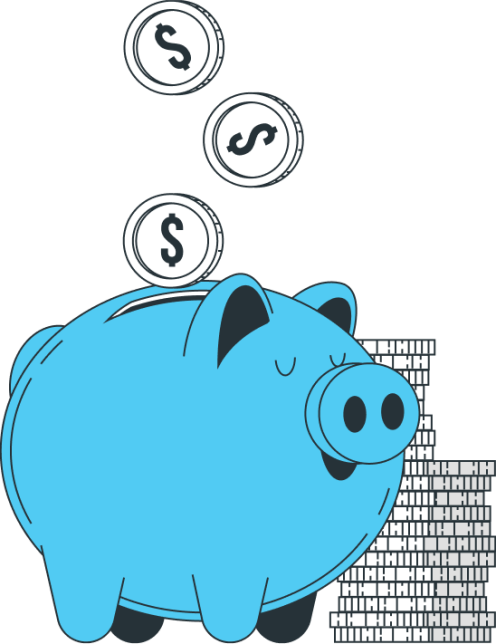In the field of marketing, ROI (meaning Return On Investment) holds a very special place. It is one of the most important constituents of marketing campaigns because it is used to measure the profitability of any action undertaken.
An ROI calculator therefore constitutes a crucial economic lever for businesses and marketers wishing to assess the true financial success of a campaign and to determine whether the investments they agreed to make were fruitful. It is just as essential when it comes to justifying expenses made, or a budget anticipated to accommodate upcoming efforts. It is the undisputed king of performance indicators! But what is a good ROI, exactly? Let’s delve deeper into the notion or marketing ROI.
What Is Marketing ROI?
Derived from the field of economic science, ROI is used to assess the performance of a marketing campaign. The acronym stands for Return On Investment, which is typically expressed as a percentage. ROI provides a comparison of the initial investments made as part of a campaign with the amount of money generated (or lost) at the end of the campaign. Thus, it makes it possible to assess the return for every euro invested. In essence, it’s all about understanding how much money a campaign made compared to how much it cost.
In terms of organisation, calculating the ROI generated by a campaign helps marketers to…
- justify expenses allocated to marketing and, by corollary, secure budgets for future campaigns;
- direct investments on the marketing actions and channels (online and offline) most profitable to the company;
- create benchmarks from which they can fine-tune their efforts and build their future campaigns;
- assess how well the company is performing within its own field of activity (specifically by comparing calculated ROI with the results of their immediate competitors, when the data is publicly available).
In short, marketing ROI aims to answer to some simple yet fundamental questions: Is my strategy cost-effective? On which actions (or channels) should I focus my investments in order to increase the profitability of my campaigns?
In that respect, Return On Investment is also a valuable decision-making tool for marketing, since the company (or its contractor) has to look towards the most profitable investment for the sums involved. In this case, ROI calculation is done in correlation with other key indicators, such as the notion of risk.
How to Calculate ROI for Marketing Purposes?
Marketing ROI is not a stand-alone indicator, and there are several ways to calculate it. With that said, the basic mathematical formula to estimate the impact of a campaign is relatively direct and consists in comparing the turnover generated with the amounts invested. The results obtained from this calculation are expressed in the form of revenue or as a percentage.
Thus:
((gains – amounts invested) / amounts invested) = ROI
For example, if you invested €20,000 and generated €30,000, the calculation is as follows:
(30,000 – 20,000) / 20,000 = €0.5, or 50%
Another example: for €1 invested, you generated €50:
(50 – 1) /1 = €49, or 4900%
With that said, it is worth keeping in mind that this calculation gives you the gross ROI (meaning before the deduction of any fees, so not based on your net income) and that the formula only takes into account financially measurable marketing efforts. In addition, it is important to apply a global reasoning and to consider the cumulated amounts – corresponding to the capital invested as well as the results obtained – over a given period for the indicator to make sense. What is a good ROI? One that exceeds the amount of your investment.
How to Measure Return on Investment?
The main benefit of marketing ROI, as an indicator, resides in how simple it is to use. Yet this apparent simplicity is only skin-deep as assessing the profitability of a marketing campaign depends on many factors. Thus, the notion of “return on investment” can vary greatly based on the means being implemented, the objectives being targeted, and the amount of money being invested. And this doesn’t even begin to consider the (many) roadblocks you may encounter, which we will touch upon later. Measuring ROI also depends on the type of campaign, of which here are three examples.
OFFLINE CAMPAIGN ROI
Marketing strategies are not all equal in terms of ROI calculation. The return on investment for a print campaign, for instance, turns out to be complex to estimate because of how difficult it is to connect a given gain to a specific action.
So, how can you tell if the revenue generated derives from the money spent to create, publish, and distribute your latest leaflet or advertising campaign on television? The result is necessarily an approximation, though there are other ways to gauge the success of such a campaign: Asking the customers directly, tracking improvements on specific indicators, monitoring vouchers or promotional codes, etc.
DIGITAL CAMPAIGN ROI
On the Internet, ROI calculation is both more accurate and more relevant, mostly thanks to web analytics (Google Analytics, for instance). This data provides information about customer behaviour and the paths they take to perform the expected action. Which is why measuring your investment ROI mainly depends on the target objective:
- In e-commerce, it’s quite simple: You consider the sales you made for every channel where the campaign was launched (partnering sites, email marketing, social media, etc.).
- In SEA, the gains generated are measured through the publicity bought. This is commonly referred to as ROAS – or Return On Advertising Spent – describing the ROI for an advertising-related expense expressed as sales revenue or as a percentage.
- For a showcase site (used to introduce your services to your prospects without direct selling), the focus is on more evanescent goals, such as enhancing the brand’s reputation, boosting the number of subscriptions to the newsletter, driving more visitors to a sales outlet, et.
A UNIQUE CASE: SEO ROI
Some marketing practices are naturally more difficult to evaluate than others in terms of return on investment. Search engine optimisation is one of them. Because it involves multiple techniques and strategies, it can be challenging to assign concrete benefits to specific SEO levers. In addition to that, the period considered (the effects of optimisation can take several months until they become evident) is another obstacle that makes measuring ROI an even more complex endeavour.
Consequently, when calculating marketing ROI for SEO, you need to rely on precise KPIs related to conversion regardless of the action you wish to consider: Filling out a form, downloading a document, subscribing to a newsletter, setting up a customer account, etc. This implies that you must first assign a certain value to every action performed and estimate how much money it generates.
Then, using an analysis tool (such as Google Analytics), you need to determine what the path from the SERP all the way to the page where the desired action is performed looks like. For this, you’ll need to set up tracking codes on the relevant pages.
The result obtained is, in nature, an approximate measurement of ROI. Yet what you may lose in precision, you gain back in durability, since SEO calls for lasting strategies, profitable in the medium and long run.
What Are the Limitations of Marketing ROI Calculation?
Marketing ROI is as essential as an indicator gets. But that doesn’t mean you should be aware of its limitations! Here are the main issues you might be faced with when measuring your return on investment:
- All by itself, an indicator such as ROI doesn’t mean all that much. For it to make sense, it needs to be compared with your business objectives. For instance, a marketing ROI of 15% may be an excellent result if you were aiming for 5%, but a very poor one if you were shooting for 40%.
- The calculation of gross ROI doesn’t take into account the profit margin of the product sold. Yet merchandise does have a cost related to the production process and the logistics involved in shipping it. This is where the formula has to be adapted to integrate the cost price, or initial value vs. present value of the product.
- Marketers often tend to focus on short-term results in order to assess how successful their efforts have been. Yet the campaigns that rely on long-term endeavours (as we touched upon above regarding SEO strategies), stretch out over several months or even years until any notable effects manifest themselves. In much the same way, those marketing investments that may be less profitable at a given time may become profitable later on. It all depends on the time period selected.
- Multichannel marketing which, by definition, spans several contact points both online and offline, makes measuring return on investment an even more complex task. When a marketer focuses on a specific channel (or on a set of channels), they are bound to cast aside every other piece of the puzzle. Measuring ROI in a coherent and relevant way implies that you must perform multiple calculations and then line up all the results.
- Most of the time, ROI calculators consider economic data, although some campaigns work towards qualitative objectives rather than quantitative ones: improving your reputation or e-reputation, retention, loyalty, etc. The profitability of your marketing campaigns can therefore have multiple and varied positive impacts that don’t translate into revenue. As essential as these may be, their reach remains difficult to assess.
- Finally, other notions are well worth considering beyond the calculation of marketing ROI, one of them being “customer lifetime value”. This term refers to the value of a customer over the duration of their relationship with the brand, which includes the total updated profit that should be expected over the course of this relationship. A customer’s profitability is therefore related to the corresponding cost of acquisition. If you spent €1 on gaining a new customer who ends up generating a profit of €100 over the course of their relationship with your brand, then their profitability is 100%.
To sum up, marketing ROI is an essential tool which is both easy to use and powerful enough to provide decisive insights to help you pilot your marketing strategies. As long as you remember to be cautious about how you handle this indicator and make sure to measure your performance using alternative methods.












